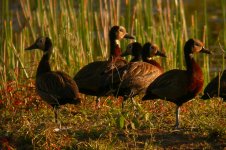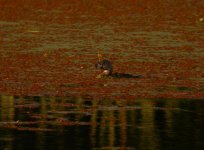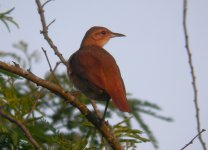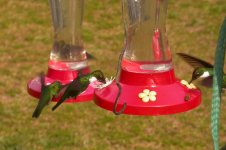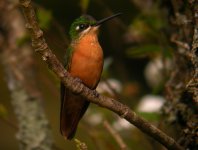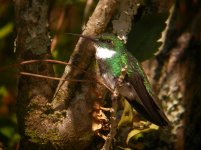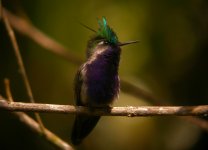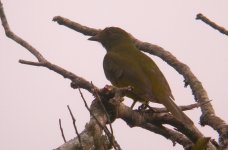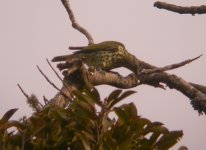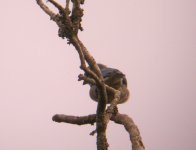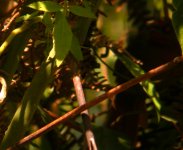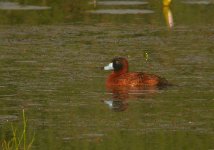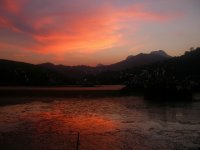
My favourite time of day at Regua is late in the afternoon, as the darkness begins to arrive. The day shift looks for somewhere to roost and the night shift begins to take over. I usually try to get out around the wetlands for an hour or so, and every day is different. My usual circuit is to walk around the lakes to the observation tower from where I can watch birds coming to roost. Then, as it gets dark, I walk around the back of the wetlands to look for night birds, torch at the ready.
This afternoon the weather was cool and cloudy, with the mist hanging low on the Serra dos Orgaos. A few Chestnut-vented Conebills were working their way through the scrub that fringes the trail. I was distracted from watching them by two birds that were flying to the new wetlands up ahead. They immediately looked different - large birds but with their long necks strangely kinked. At first they almost reminded me of geese, but then I realised they were herons. They gave away their identity when they landed on a snag and begin bowing at one another and giving a shrill whistle that soon turned into a strange donkey-like braying. These were Whistling Herons, a bird that had previously eluded me in Brazil. They were much stranger birds than I expected. Not only was there the bizarre call but there was the peculiar appearance of the birds in flight, necks outstretched but kinked in the middle and a striking bowed wing action. They stayed on their snag for a few minutes before moving to another tree on the other side of the wetland, perhaps to roost there.
From the tower I could see and hear a lot of what was going on. Hundreds of Cattle Egrets came in from all directions to roost on the woody islands in the main lake. Swarming into the rush beds were Chestnut-capped Blackbirds and this evening they were joined by lots of iridescent blue-black Shiny Cowbirds.
As the amphibian and insect chorus gathered momentum, the rails and crakes begin to call. From either side I could hear the intense trilling of Rufous-sided Crakes and the contrasting duet song of Ash-throated Crake. Several Blackish Rails squealed invisibly from the rushes and in the distance I could make out the peculiar yammering of Slaty-breasted Wood-rail.
I walked around the back of the wetlands and played out a recording of Giant Snipe. Eventually I heard some distant birds responding but I didn't see any fly in. A few Black-crowned Night Herons flew out of the wetlands as the last few Great Egrets came into roost. A pair of Muscovey Ducks were lurking on the furthest pools and several groups of Brazilian Teal made there way off up the valley, as they seem to every evening, going who knows where. A Tropical Screech Owl called a few times from the forest but not many other night birds were making a sound. Perhaps the almost full moon was inhibiting their nocturnal habits. Pauraques were less concerned and there were several giving their distinctive tremulous whistle. I saw at least four in the torch light as I walked back around the edge of the wetland.
This afternoon the weather was cool and cloudy, with the mist hanging low on the Serra dos Orgaos. A few Chestnut-vented Conebills were working their way through the scrub that fringes the trail. I was distracted from watching them by two birds that were flying to the new wetlands up ahead. They immediately looked different - large birds but with their long necks strangely kinked. At first they almost reminded me of geese, but then I realised they were herons. They gave away their identity when they landed on a snag and begin bowing at one another and giving a shrill whistle that soon turned into a strange donkey-like braying. These were Whistling Herons, a bird that had previously eluded me in Brazil. They were much stranger birds than I expected. Not only was there the bizarre call but there was the peculiar appearance of the birds in flight, necks outstretched but kinked in the middle and a striking bowed wing action. They stayed on their snag for a few minutes before moving to another tree on the other side of the wetland, perhaps to roost there.
From the tower I could see and hear a lot of what was going on. Hundreds of Cattle Egrets came in from all directions to roost on the woody islands in the main lake. Swarming into the rush beds were Chestnut-capped Blackbirds and this evening they were joined by lots of iridescent blue-black Shiny Cowbirds.
As the amphibian and insect chorus gathered momentum, the rails and crakes begin to call. From either side I could hear the intense trilling of Rufous-sided Crakes and the contrasting duet song of Ash-throated Crake. Several Blackish Rails squealed invisibly from the rushes and in the distance I could make out the peculiar yammering of Slaty-breasted Wood-rail.
I walked around the back of the wetlands and played out a recording of Giant Snipe. Eventually I heard some distant birds responding but I didn't see any fly in. A few Black-crowned Night Herons flew out of the wetlands as the last few Great Egrets came into roost. A pair of Muscovey Ducks were lurking on the furthest pools and several groups of Brazilian Teal made there way off up the valley, as they seem to every evening, going who knows where. A Tropical Screech Owl called a few times from the forest but not many other night birds were making a sound. Perhaps the almost full moon was inhibiting their nocturnal habits. Pauraques were less concerned and there were several giving their distinctive tremulous whistle. I saw at least four in the torch light as I walked back around the edge of the wetland.




